
Are recent developments in US carmaking a sign of an industry in crisis, or is there a fundamental shift in manufacturing and how profits are measured?
In once-humming US car factories, there is an eerie stillness as production lines shut down and layoff slips are handed out. The so-called ‘rust belt’ is creeping westwards, the area once limited to decommissioned steel mills expanding to include defunct production facilities, the term taking on a larger, more ominous meaning in the 21st century global economy.
In distressed Detroit, carmakers jump from the frying pan to the fire – and back again – with monotonous repetition. Production and sales are down for the domestic Big Three, now renamed the Detroit Three. Manufacturers are having to rely on off-shore investments to prop up losses on home turf, while suppliers are squeezed to breaking point to lower costs. Skittish consumers watch oil prices rocket and house prices slump; and the economy has a full-blown case of influenza. “The United States may well become the new Mexico,” quips one official with a major consulting firm in Detroit, as jobs and production pour out of the slumping manufacturing region. Which leaves US auto workers with just one question: “How do you support the local market by buying domestic cars if you’re out of work?”
Downsizing in the land of big
The general malaise hanging over the US car industry is clearly demonstrated by recent sales figures. Declines in April were followed by similarly poor performances in May. Year-on-year, GM lost 12 per cent over the same period in 2007. Ford fared little better, with sales dropping 16 per cent, though sales of the Focus and Fusion were up 53 and 27 per cent respectively, signalling a clear shift by consumers to smaller cars. Sales for Toyota were down eight per cent, this despite increases in small car and hybrid sales, while Nissan reported a 4.4 per cent increase. While this is going on, modern plants and technical centres are springing up across China, India, Russia and Eastern Europe, assembly lines ramp up and workers find much more than a chicken in every pot.
Industry-pioneering suppliers are also struggling. Household names such as Delphi and Visteon, Plastech, Dana, ArvinMeritor, Siemens VDO and Federal-Mogul have either struggled with bankruptcy or are in budget doldrums. AlixPartners, a global consultation and restructuring firm estimates that nearly a third of the North American supply base is in deep financial distress – and is being consistently outperformed financially by its European and Asian counterparts.
“Together with the avalanche of supplier bankruptcies, 27 per cent of North American suppliers face fiscal danger (possible insolvency) within 24 months,” says John Hoffecker, Managing Director of AlixPartners, citing a 2007 OEM and supplier survey that the company compiled. Within just five years, North America, Europe and Japan will together make up only about 50 per cent of the global auto market, down from a commanding 75 per cent stake in the industry, according to the Alix report. The remainder will be shared between China, India, South America, Eastern Europe and other emerging, low-cost production regions.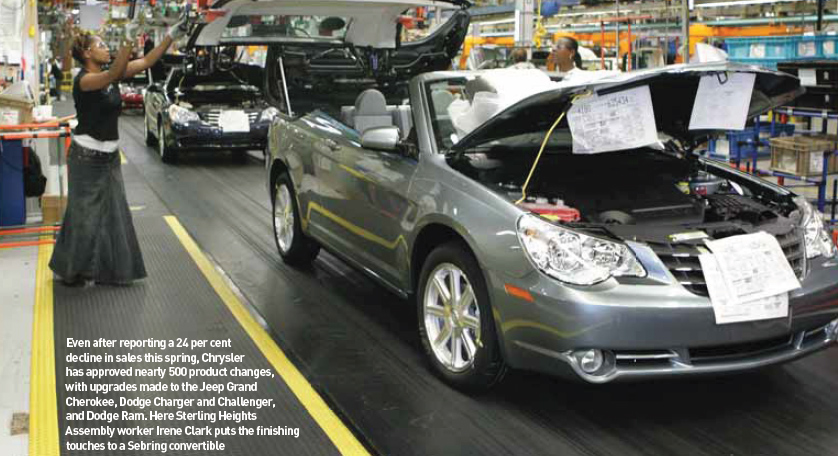
The suppliers’ future is not bright
Steve Widdett, Executive Vice-President of Sales and Marketing for Hella USA notes that industry volume expectations have been steadily reducing as the year progresses. As a subsidiary of the German auto industry supplier, the company has witnessed companies slashing 2008 production targets. Already they are down from 15.1 million units in 2007 to 14.5 million in 2008, and there could still be further reductions. “This means that for most suppliers, even very conservative industry estimates built into last year’s forecast for this year are probably going to be underachieved. The whole economy is witnessing additional pressures through rising commodity prices, restricted credit, and this is impacting the housing market and is directly reflecting vehicle sales, particularly in the truck segment,” says Widdett.
 “Our key customers in North America are all going through significant structural changes and we hope that we will see these benefits reflected in our combined businesses towards year-end and early 2009,” he tells AMS. Thirteen per cent of Hella’s North American business is with NAFTA (North American Free Trade Agreement) OEMS – a troubling signal, considering the market region’s meagre two per cent growth last year. That compares with Asia at six per cent, a year-on-year increase of 46.4 per cent. Dr Martin Fischer, President of Hella USA adds, “The focus on cost, and therefore price reduction, remains for all products, and is only accentuated in the kind of market conditions that we are now experiencing. We are continuing to work on cost-reduction activities for all our products, including value analysis and engineering, and we are reviewing our manufacturing footprint and purchasing efforts.”
“Our key customers in North America are all going through significant structural changes and we hope that we will see these benefits reflected in our combined businesses towards year-end and early 2009,” he tells AMS. Thirteen per cent of Hella’s North American business is with NAFTA (North American Free Trade Agreement) OEMS – a troubling signal, considering the market region’s meagre two per cent growth last year. That compares with Asia at six per cent, a year-on-year increase of 46.4 per cent. Dr Martin Fischer, President of Hella USA adds, “The focus on cost, and therefore price reduction, remains for all products, and is only accentuated in the kind of market conditions that we are now experiencing. We are continuing to work on cost-reduction activities for all our products, including value analysis and engineering, and we are reviewing our manufacturing footprint and purchasing efforts.”
Just how deep does supplier and OEM distress go? It’s not all doom and gloom, say consultants. Clearly, global competition is fi erce. But for those who enjoy challenges and are willing read customer needs and risk investments in innovation, the future is not as bleak as it might seem. Even in electronics, renowned to be the fastest-growing area in automotive content, suppliers face challenges, but these can be overcome with creative collaborations, mergers and buyouts. Paul Hansen, an auto industry consultant who publishes The Hansen Report on Automotive Electronics, says the whole supply chain is suffering from the problems of the Detroit Three. “GM, Ford and Chrysler are bleeding – with under 15 million units due for production this year. We are witnessing a great deal of pain and discomfort as the industry adjusts to the realities of this intensely competitive market. A number of companies have walked away from the industry.” One such example is Motorola.
Others that have waved goodbye to auto manufacturing are United Technologies, Philips Electronics and the former parent of TRW. Siemens VDO walked away from the business, only to be absorbed by Continental. “From 1996 to 2007, Siemens VDO was the fastest-growing automotive electronics supplier on the planet,” Hansen notes. But the newly-merged company could be in for a bumpy ride. Specialists are thriving Long-time market leader Delphi has been stuck in bankruptcy proceedings for two years. “Delphi was unable to get the exit fi nancing needed - not only because of its own problems, but also because of the unfortunate coincidence of the global credit crisis, the worst I have seen. And that’s just some of the bad news,” he adds. While the industry has been tough on some full-line automotive electronics companies, specialists seem to be thriving, according to Hansen. He cites KPIT Cummins, an India-based embedded software services company, which takes on automotive software projects for signifi cantly less than what it would cost to have the same work completed in the US, Europe or Japan. Other companies are adjusting their forecasts and production as best they can - while diversifying their client base. Key to this strategy is taking advantage of areas where production can continue at a profi t, generally the emerging, low-cost countries. Yet despite this off-shore potential, Hansen notes that the US is slowing down its overseas expansion, with the lowest rate of investment seen in the past 20 years. Centres of excellence Tracy Handler, analyst at Global Insight, believes one good move is the development of centres of excellence designed to promote the sharing of global resources and production. Another is the trend of increased collaboration between competitors, OEMs and suppliers. “We’re seeing more off-shore centres of excellence in production.
We’re also seeing more cooperation at OEM level, such as the Nissan and Chrysler production agreement, as they play off each other’s expertise.” Nissan Motor and Chrysler have announced that they would build key vehicles for each other. Chrysler will assemble pick-up trucks for Nissan using the Japanese automaker’s unique body style requirements, beginning in 2009. Also, a Nissan plant in Japan will produce a Chrysler compact car for the struggling US company. Overall, Handler expects to see a decline in US-based investments, but more foreign investment. Volkswagen of Europe, for example, is looking to build a plant in the US, with an announcement planned for July. In terms of the multiple challenges facing domestic carmakers, an AlixPartners study cited a ‘profi t indifference curve’ – as market and regulatory pressures move productline mixes away from SUVs and other light trucks over to passenger cars, every fi fth of a per cent shift in model mix would have to be accompanied by a three- to four-per cent increase in total company vehicle sales just to maintain the same operating profi t levels. “With the domestics currently having more than 60 per cent of their mix in light trucks, they’re going to have to run incredibly fast just to stay in the same place,” said John Hoffecker, Managing Director of Alix Partners.
The complete analysis covered 51 worldwide automakers, 25 heavyvehicle producers and 297 auto suppliers, comparing them across various metrics. Some other major fi ndings included: - North American suppliers are being outperformed fi nancially by European competitors; - India could become a larger auto market than Brazil, France or South Korea in the next six years. Additionally, Indian suppliers could potentially go on an acquisitions ‘binge’, following that of companies such as Bharat Forge, the world’s second-largest forging company; - China, with auto components exports to the US up 38 pe rcent in 2006, is on track to permanently pass Germany in that area; - Market capitalisation (stock price times shares outstanding) of Chinese and Indian automakers together is now larger than that of GM and Ford combined, even though the latter’s revenues are ten times greater.
Strikes cause a ripple effect The prolonged labour dispute at American Axle & Manufacturing Holdings is symptomatic of Detroit’s troubles. The mid-size parts supplier makes axles, driveshafts, stabiliser bars and other components, mainly for pick-ups and large SUVs. About 70 per cent of its business is with GM. At its height, the 10-week strike idled at least 34 factories in the US, Canada and Mexico.
The strike involved about 3,650 UAW associates at five facilities in Michigan and New York. Competitive wage concessions were at the heart of the acrimony between workers and management, with workers rejecting lower pay and buyout options.
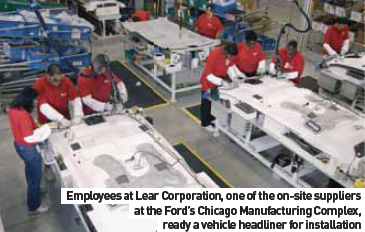 Matt Simoncini, CFO and Senior Vice-President of Lear Corporation said in May that the AAM strike alone had cost the auto industry an estimated 90,000 units in lost production, based on the shutdowns. “The impact on Lear specific to [strike-related] plant shut downs was about 80,000 units, since not all the affected platforms were from Lear platforms,” says Simoncini. “Prior to the strike, through the first half of the quarter, we were actually running a little ahead of our production expectations. Now, if you look at it in terms of revenue, the costs-per-vehicle average for the units affected were in the US$1,100 range, since the majority of them were full-sized pick-ups.”
Matt Simoncini, CFO and Senior Vice-President of Lear Corporation said in May that the AAM strike alone had cost the auto industry an estimated 90,000 units in lost production, based on the shutdowns. “The impact on Lear specific to [strike-related] plant shut downs was about 80,000 units, since not all the affected platforms were from Lear platforms,” says Simoncini. “Prior to the strike, through the first half of the quarter, we were actually running a little ahead of our production expectations. Now, if you look at it in terms of revenue, the costs-per-vehicle average for the units affected were in the US$1,100 range, since the majority of them were full-sized pick-ups.”
Strength in international operations
“We did benefit in the quarter with about US$25 million because of the timing of commercial settlements and legal resolutions. Seating benefited in a range of about US$20 (per unit), electrical was about US$5. But at the core, we had underlying strength in our operations. We’re seeing increased benefits from restructuring year-on-year, good strong performance in the operations and cost reductions, manufacturing efficiencies and strength in our international operations,”
Also, Lear was getting its own house in order after settling a protracted 2007 takeover attempt by investor Carl Icahn, valued at $5.3 billion. Lear took the decision to fight the buyout after its major shareholders opposed the takeover, part of which saw the supplier divest its auto interiors business to concentrate on seating and electronics. “Core products such as wiring, junction box, remote keyless entry, tyre pressure monitoring, seating and lighting are required in every vehicle, but the central issue today is cost,” says Mike Fawaz, Lear’s Vice-President of Central Engineering - Electronic Products. “These days, there are suppliers in various product groups that have the capability and quality, but the key is getting to the lowest price possible and meeting customer expectations.”
As a result, new product development is focused solely on core products that fit Lear’s growth strategy. According to Fawaz, common process, safety and environmental products are the best areas for innovation and sales growth. Lear Chairman and CEO Bob Rossiter says the company will expand its group electronics offerings during the next three to five years, with plans to make that unit as large as its seating division. The company has been restructuring its operations, moving business and production to lower-cost regions, particularly in Asia. Rossiter noted that offshore development is key to being competitive in the traditional markets and is needed to support Lear and its local markets.
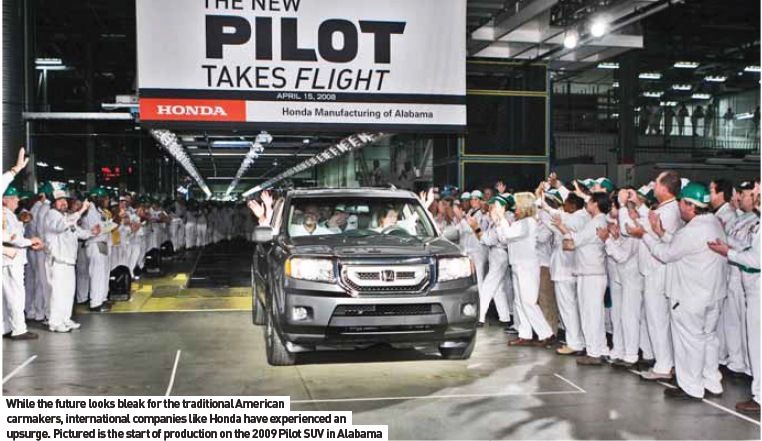
The future’s not bright
Production forecasts are at their lowest level in 15 years, driven by consumers shifting to more fuel-efficient vehicles and rising energy, material and commodity costs, says Don Bernhardt, Lear’s Vice-President - Product Engineering for North America.
“Being committed to innovation, ebbs and flows in the economy of a particular region are not the driving factor for R&D. Yes, the economic climate is tough in North America, but Lear is a global company so when we develop products and state-of-the-art manufacturing techniques, we focus on the global market. “It also allows us to balance our engineering resources to take advantage of low-cost engineering worldwide. Our main locations for low-cost engineering, design and simulated validation reside in China, India, and the Philippines,” he adds.
Some companies that have struggled in the past have managed to turn the corner, again citing global profits as the reason. After surviving a Chapter 11 reorganisation lasting several years, Federal-Mogul posted record first quarter financial results with sales of US$1.86 billion, an eight per cent increase over the same period last year. Jose Maria Alapont, President and CEO, says the company was pleased with the strong quarter, a payoff from solid operating performance, and customer, regional and product diversification.
“More than 60 per cent of our revenue in the quarter was generated outside the United States. The improvements came as a result of our restructuring and cost-reduction efforts as outlined in our strategy for sustainable global profit growth,” he explains.
For Canadian parts giant Magna International, 2007 saw it become the largest automotive supplier in the North American region. Despite such highs company CEO Don Walker expects the supplier situation to worsen, because of market conditions and energy issues. “If you look at the economy, sinking volumes, the financial situation and banks, the pressures on the car companies, I think we’re going to see acceleration in the number of auto parts suppliers that will fail.”
Off-shore gains give GM a push
GM reported a loss of US$3.6 billion in North American automotive revenue in the first quarter of 2008, largely as a result of losses from Delphi bankruptcy proceedings and the sluggish US economy. Yet the carmaker’s European and Asian profits skyrocketed to US$75 million, up from US$4 million the previous year.
While the bottom line continues to tighten in Detroit, GM and other carmakers are continuing to align global resources, setting up manufacturing and engineering operations in ‘centres of expertise’ – meaning that specific regions assume responsibility for their particular areas of specialty. An example of this could see the US being assigned small car development, India the electronics and China the powertrain and engine production. Daniel Hancock, Vice-President of Engineering Operations for GM Powertrain says that the carmaker’s global strategy includes centralising core responsibility around each product architecture, while maintaining the flexibility to shift work to different locations to meet current business needs. “Globalisation allows commonisation, product design and engineering. It also provides economies of scale, through common manufacturing and shared learning.”

Near the Rocky Mountains of Colorado in Golden sits the National Renewable Energy Lab (NREL), a percolator for renewable fuels science and technology. The outfi t is run by the United States Department of Energy. Dale Gardner, NREL Associate Director of Renewable Fuels Science and Technology, says that energy diversity is the ‘next big thing’. He was one of the speakers at the “Future of Energy – Field to Wheel” forum, held as part of the SAE International World Congress in Detroit in April. According to Gardner, the DoE and Environmental Protection Agency are jointly conducting studies to determine the impact increased biofuel use will have on the world’s food supply and environment. Clean diesel engines will get another look as will fuel-effi cient hybrids, ethanol and biofuel vehicles, hydrogen fuel cells and other forms of alternative energy.
Spiking oil prices and stringent corporate average fuel economy (CAFE) standards from the US Department of Transportation are causing automakers to rethink business plans. Oil prices have skyrocketed to past $130 a barrel, up from $60 only a few years ago.
In response, CAFE standards set in 2007 require OEMs to reach new effi ciency levels on the way to the 35 mpg average they must reach by 2020. Automakers had to put on hold projects awaiting a new interim standard. This year, for example, General Motors cancelled its $3-billion Ultra V8 programme, intended to replace Cadillac’s Northstar V8 engine. According to Gardner, “We want to go to cellulosic ethanol but there are production cost issues – now costing $2.35 a gallon, the equivalent of $3.50 per gallon of petrol.” The DoE hopes to see costs go to $1.31-agallon cellulosic ethanol by 2012, equaling $2-a-gallon gasoline, he said. But $3.50 may sound good these days, except that is not the price at the pump. It is the cost at the refinery gate, so does not include taxes and distribution costs.
There are also infrastructure and distribution cost issues and the supply of so-called fl ex fuels. Gardner says that there are only 1,200 public E85 (ethanol) stations in the country and about 60,000 are needed. There are also about 120 private stations owned primarily by fl eet owners. Automakers say they are shouldering most of the costs of making vehicles more fuel-effi cient, since many US consumers are unwilling to pay for higher fuel economy in vehicles.
Carmakers are taking the development risk
“The automaker is taking this (development) risk until consumers decide (if ever) to pay for it,” says Robert Lee, Vice President of Powertrain Product Engineering at Chrysler. “I am in this game of making something consumers may not pay for – for the good of us all.” An SAE engineering panel indicated that diesel-powered vehicles could account for 20 per cent of US vehicles in the near future. Diesels account for more than half of all vehicles in Europe, in part because diesel faces lower taxation.
Dave McCurdy, President and CEO of the Alliance of Automobile Manufacturers, says automakers are willing to be a critical part of the national debate on energy and emissions, but they can’t do it alone. “There needs to be a national, federal, economy-wide approach to addressing greenhouse gases. This decision says that the US Environmental Protection Agency will be part of this process.” Alternative fuel vehicles, including hybrids, diesel and ethanol-capable vehicles, enhance energy security because the alternative fuels are the most effective way to reduce gallons of fuel used, McCurdy noted. Toyota, a leader in the green car movement, has sold 1.3 million hybrids worldwide since it launched the 60-mpg Prius in Japan in 1998. Hybrids now account for 10 per cent of annual US sales, according to Tom Stricker, of Toyota Motor Company.
When the chips are down . . .
Even after reporting a 24 per cent decline in spring sales, Chrysler has plans to remain one of the Detroit Three. Production executives are confident about a turnaround, with some suggesting that claims of industry demise in Detroit are widely exaggerated. According to Frank Klegon, Executive Vice- President of Product Development: “This turbulence has caused some observers to wonder aloud about the future of the automotive industry. Chrysler’s privately-held status [following the purchase of 80% of Chrysler stock by Cerberus Capital last year] has infused the company with new direction.” Since the buyout in August 2007), the carmaker has approved nearly 500 product changes, with upgrades made to the Jeep Grand Cherokee, Dodge Charger and Challenger, and Dodge Ram.
Ford’s multi-million dollar face-lift
Despite suffering years of financial setbacks to its US operations, Ford has enjoyed a US$100 million lift, mainly as a result of its overseas business. CEO Alan Mulally said earlier this year that the company’s recovery plan was on track, forecasting North American profitability in 2009. All is not rosy with the blue oval however – buried in the good news was a little-disguised US$4 billion decline in North American revenue.
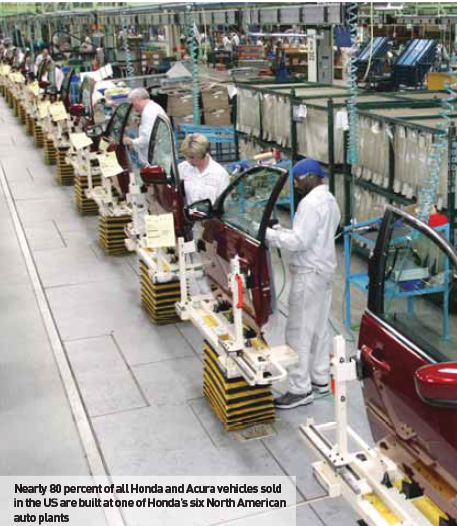
Further revisions have been made in production and profit forecasts, as Mulally, supported by a selection of Ford executives, announced that the company was only expected to ‘about break even’ next year, this before taxes and special items. The turnaround was, once again, stalled. “We are profitable and growing outside of North America, and our transformation plan is working,” said Mulally, disguising the bad news with a spoon of sugar. He quickly added that the entire industry is being hammered by “the accelerating shift in consumer demand away from large trucks and SUVs to smaller cars and crossovers.”
Shifting the profitability goalposts
“Unless there is a fairly rapid turnaround in US business conditions, which we are not anticipating, it now looks like it will take longer than expected to achieve our North American automotive profitability goal. Overall, we expect to be about break-even companywide in 2009 – with continued strong results in Europe and South America,” he is quoted as saying. Ford has cut 35 per cent of its North American workforce since 2005 to ease financial losses. The company said more cuts were expected in July.
US light vehicle sales dropped nine per cent to 4.82 million units in the first four months of 2008, led by an 18 per cent decrease in truck sales and a 26 per cent plunge in SUV sales. “As a result of high gas prices, compact car and hybrid market share are predicted to reach an all-time high this month,” says Jesse Toprak, analyst at industry-tracking firm edmunds.com. Even popular Asian and European brands that had been profitable are feeling the bite. Toyota posted a fifth straight month of falling US sales in April, compared with the same month in 2007, while companies such as BMW of North America and Mercedes-Benz USA are discovering that their American investments and resources are shrinking.
John Hoffecker, of AlixPartners says, “Some high-end European automakers selling products in the United States, including ones built here, are now absorbing up to a 40 per cent disadvantage compared with prices commanded for the same vehicles in Europe.”
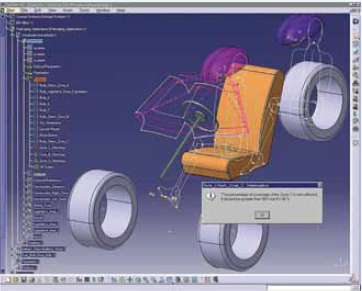 Bob Brincheck at Dassault Systeme’s DELMIA technology group says that carmakers are increasing global collaboration to design and build anywhere, anytime in the world as they combat high costs in mature economies. “It’s easier to grow business in a fast-growing market than to claw and scrabble in a slower market. You can lose market share and still make gains simply because the market is growing so fast,” says Brincheck, DELMIA’s PLM Sales Director. Suppliers and OEMs have design centres in multiple locations, helping manufacturers to engage in global product development throughout the USA, China, India, Germany, Korea, and other off-shore ‘hot spots’. Low-cost countries like India are on the rise, but they have highly educated workers. To keep them from leaving, they either need to be paid more, or offer them cutting-edge tools and programs with which to work, Brincheck says. OEMs are not completely outsourcing all engineering, but getting high engineering costs down by using sophisticated knowledge-based software such as those offered by CATIA V5. A new CATIA V6 knowledge template called Knowledgeware is being developed and is due to be released in the next few months. The coming V6 program incorporates 3D PLM, a universal 3D tool. “It moves away from the conventional fi le-based PLM/PDM systems which rely on documents. V6 is a server-orientated architecture that puts data management in the background by allowing users to navigate through product structure in 3D, as well as a single server for everyone accessing the information from around the world,” Brincheck explains. Carmakers can use knowledge templates to capture know-how and best practices and then store the knowledge for re-use to develop better quality products faster, while eliminating non-value added time. It can also mean that a design that might take 75 hours to develop can be cut to 25 hours by companies using sophisticated tools like CATIA.
Bob Brincheck at Dassault Systeme’s DELMIA technology group says that carmakers are increasing global collaboration to design and build anywhere, anytime in the world as they combat high costs in mature economies. “It’s easier to grow business in a fast-growing market than to claw and scrabble in a slower market. You can lose market share and still make gains simply because the market is growing so fast,” says Brincheck, DELMIA’s PLM Sales Director. Suppliers and OEMs have design centres in multiple locations, helping manufacturers to engage in global product development throughout the USA, China, India, Germany, Korea, and other off-shore ‘hot spots’. Low-cost countries like India are on the rise, but they have highly educated workers. To keep them from leaving, they either need to be paid more, or offer them cutting-edge tools and programs with which to work, Brincheck says. OEMs are not completely outsourcing all engineering, but getting high engineering costs down by using sophisticated knowledge-based software such as those offered by CATIA V5. A new CATIA V6 knowledge template called Knowledgeware is being developed and is due to be released in the next few months. The coming V6 program incorporates 3D PLM, a universal 3D tool. “It moves away from the conventional fi le-based PLM/PDM systems which rely on documents. V6 is a server-orientated architecture that puts data management in the background by allowing users to navigate through product structure in 3D, as well as a single server for everyone accessing the information from around the world,” Brincheck explains. Carmakers can use knowledge templates to capture know-how and best practices and then store the knowledge for re-use to develop better quality products faster, while eliminating non-value added time. It can also mean that a design that might take 75 hours to develop can be cut to 25 hours by companies using sophisticated tools like CATIA.
A sixyear product change time is pared to two or three years or less, he adds. In a special assessment project, Dassault determined that Hyundai/ Kia could save $3 million per year, the equivalent of 51,000 engineering hours or 25 full-time engineers in vehicle design with reusable templates and creating global standards for structuring designs. PLM collaboration tools also let operators see data visually in 3D. Also, the templates preserve the original design intent through a component morphing process. Certain features are selected as changeable elements of the part design. “Another advantage of the technology is that it allows automakers to become more efficient and differentiate themselves in the marketplace,” Brincheck says.


































